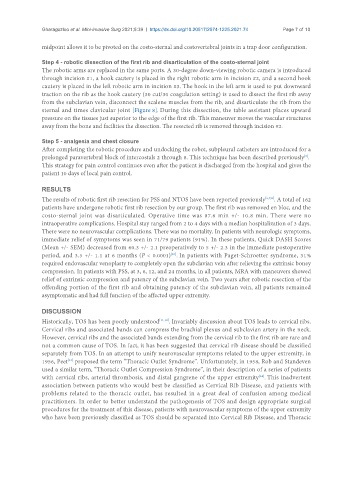Page 391 - Read Online
P. 391
Gharagozloo et al. Mini-invasive Surg 2021;5:39 https://dx.doi.org/10.20517/2574-1225.2021.74 Page 7 of 10
midpoint allows it to be pivoted on the costo-sternal and costovertebral joints in a trap door configuration.
Step 4 - robotic dissection of the first rib and disarticulation of the costo-sternal joint
The robotic arms are replaced in the same ports. A 30-degree down-viewing robotic camera is introduced
through incision #1, a hook cautery is placed in the right robotic arm in incision #2, and a second hook
cautery is placed in the left robotic arm in incision #3. The hook in the left arm is used to put downward
traction on the rib as the hook cautery (30 cut/30 coagulation setting) is used to dissect the first rib away
from the subclavian vein, disconnect the scalene muscles from the rib, and disarticulate the rib from the
sternal and times clavicular joint [Figure 8]. During this dissection, the table assistant places upward
pressure on the tissues just superior to the edge of the first rib. This maneuver moves the vascular structures
away from the bone and facilities the dissection. The resected rib is removed through incision #2.
Step 5 - analgesia and chest closure
After completing the robotic procedure and undocking the robot, subpleural catheters are introduced for a
prolonged paravertebral block of intercostals 2 through 8. This technique has been described previously .
[9]
This strategy for pain control continues even after the patient is discharged from the hospital and gives the
patient 10 days of local pain control.
RESULTS
The results of robotic first rib resection for PSS and NTOS have been reported previously [6,7,8] . A total of 162
patients have undergone robotic first rib resection by our group. The first rib was removed en bloc, and the
costo-sternal joint was disarticulated. Operative time was 87.6 min +/- 10.8 min. There were no
intraoperative complications. Hospital stay ranged from 2 to 4 days with a median hospitalization of 3 days.
There were no neurovascular complications. There was no mortality. In patients with neurologic symptoms,
immediate relief of symptoms was seen in 71/79 patients (91%). In these patients, Quick DASH Scores
(Mean +/- SEM) decreased from 60.3 +/- 2.1 preoperatively to 5 +/- 2.3 in the immediate postoperative
period, and 3.5 +/- 1.1 at 6 months (P < 0.0001) . In patients with Paget-Schroetter syndrome, 31%
[10]
required endovascular venoplasty to completely open the subclavian vein after relieving the extrinsic boney
compression. In patients with PSS, at 3, 6, 12, and 24 months, in all patients, MRA with maneuvers showed
relief of extrinsic compression and patency of the subclavian vein. Two years after robotic resection of the
offending portion of the first rib and obtaining patency of the subclavian vein, all patients remained
asymptomatic and had full function of the affected upper extremity.
DISCUSSION
Historically, TOS has been poorly understood [11,12] . Invariably discussion about TOS leads to cervical ribs.
Cervical ribs and associated bands can compress the brachial plexus and subclavian artery in the neck.
However, cervical ribs and the associated bands extending from the cervical rib to the first rib are rare and
not a common cause of TOS. In fact, it has been suggested that cervical rib disease should be classified
separately from TOS. In an attempt to unify neurovascular symptoms related to the upper extremity, in
[13]
1956, Peet proposed the term “Thoracic Outlet Syndrome”. Unfortunately, in 1958, Rob and Standeven
used a similar term, “Thoracic Outlet Compression Syndrome”, in their description of a series of patients
[14]
with cervical ribs, arterial thrombosis, and distal gangrene of the upper extremity . This inadvertent
association between patients who would best be classified as Cervical Rib Disease, and patients with
problems related to the thoracic outlet, has resulted in a great deal of confusion among medical
practitioners. In order to better understand the pathogenesis of TOS and design appropriate surgical
procedures for the treatment of this disease, patients with neurovascular symptoms of the upper extremity
who have been previously classified as TOS should be separated into Cervical Rib Disease, and Thoracic

